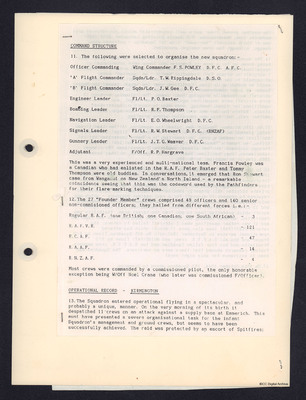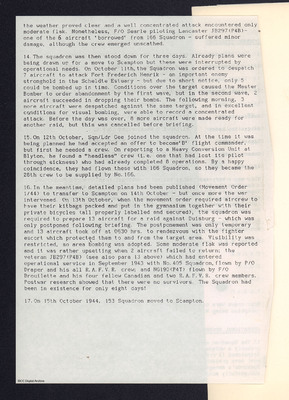166 Squadron history
Title
166 Squadron history
Description
Covers command structure on formation and names commanders. Mentions original multinational crews. Covers some details of operational record at RAF Kirmington. Concludes with move to RAF Scampton and formation of 153 Squadron.
Spatial Coverage
Coverage
Language
Type
Format
Two page printed document
Publisher
Rights
This content is available under a CC BY-NC 4.0 International license (Creative Commons Attribution-NonCommercial 4.0). It has been published ‘as is’ and may contain inaccuracies or culturally inappropriate references that do not necessarily reflect the official policy or position of the University of Lincoln or the International Bomber Command Centre. For more information, visit https://creativecommons.org/licenses/by-nc/4.0/ and https://ibccdigitalarchive.lincoln.ac.uk/omeka/legal.
Contributor
Identifier
SJenkinsonPR1826262v10008
Transcription
[underlined] COMMAND STRUCTURE [/underlined]
11. The following were selected to organise the new squadron:-
Officer Commanding Wing Commander F.S. POWLEY D.F.C. A.F.C.
‘A’ Flight Commander Sqdn/Ldr. T.W. Rippingdale D.S.O.
‘B’ Flight Commander Sqdn/Ldr. J.W. Gee D.F.C.
Engineer Leader Fl/Lt. P.O. Baxter
Bombing Leader Fl/Lt. R.F. Thompson
Navigation Leader Fl/Lt. E.O. Wheelwright D.F.C.
Signals Leader Fl/Lt. R.W. Stewart D.F.C. (RNZAF)
Gunnery Leader Fl/Lt. J.T.G. Weaver D.F.C.
Adjutant F/Off. R.P. Hargrave
This was a very experienced and multi-national team. Francis POwley was a Canadian who had enlisted in the R.A.F. Peter Baxter and Tommy Thompson were old buddies. In conversations, it emerged that Ron Stewart came from Wanganui on New Zealand’s North Island - a remarkable coincidence seeing that this was the codeword used by the Pathfinders for their flare-marking techniques.
12. The 27 “Founder Member” crews comprised 49 officers and 140 senior non-commissioned officers; they hailed from different forces i.e.:-
Regular R.A.F. (one British; one Canadian; one South African) - 3
R.A.F.V.R. - 121
R.C.A.F. - 47
R.A.A.F. - 14
R.N.Z.A.F. - 4
Most crews were commanded by a commissioned pilot, the only honorable [sic] exception being W/Off Noel Crane (who later was commissioned F/Officer).
[underlined] OPERATIONAL RECORD [/underlined] - [underlined] KIRMINGTON [/underlined]
13. The squadron entered operational flying in a spectacular, and probably unique, manner. On the very morning of its birth it despatched 11 crews on an attack against a supply base at Emmerich. This must have presented a severe organisational task for the infant Squadron’s management and ground crews, but seems to have been successfully achieved. The raid was protected by an escort of Spitfires;
[page break]
the weather proved clear and a well concentrated attack encountered only moderate flak. Nonetheless, F/O Searle piloting Lancaster JB297(P4B) - one of the 6 aircraft ‘borrowed’ from 166 Squadron - suffered minor damage, although the crew emerged unscathed.
14. The squadron was then stood down for three days. Already plans were being drawn up for a move to Scampton but these were interrupted by operational needs. On October 11th, the Squadron was ordered to despatch 7 aircraft to attack Fort Frederich Henrik - an important enemy stronghold in the Scheldte Estuary - but due to short notice, only 5 could be bombed up in time. Conditions over the target caused the Master Bomber to order abandonment by the first wave, but in the second wave, 2 aircraft succeeded in dropping their bombs. The following morning, 3 more aircraft were despatched against the same target, and in excellent conditions for visual bombing, were able to record a concentrated attack. Before the day was over, 8 more aircraft were made ready for another raid, but this was cancelled before briefing.
15. On 12th October, Sqn/Ldr Gee joined the squadron. At the time it was being planned he had accepted an offer to become ‘B’ flight commander, but first needed a crew. On reporting to a Heavy Conversion Unit at Blyton, he found a “headless” crew (i.e. one that had lost its pilot through sickness) who had already completed 8 operations. By a happy coincidence, they had flown these with 166 Squadron, so they became the 28th crew to be supplied by No. 166.
16. In the meantime, detailed plans had been published (Movement Order 1/44) to transfer to Scampton on 14th October - but once more the war intervened. On 13th October, when the movement order required aircrew to have their kitbags packed and put in the gymnasium together with their private bicycles (all properly labelled and secured), the squadron was required to prepare 13 aircraft for a raid against Duisburg - which was only postponed following briefing. The postponement was only temporary and 13 aircraft took off at 0630 hrs. to rendezvous with the fighter escort which protected them to and from the target area. Visibility was restricted, so area bombing was adopted. Some moderate flak was reported and it was rather upsetting when 2 aircraft failed to return; the veteran JB297(P4B) (see also para 13 above) which had entered operational service in September 1943 with No. 405 Squadron, flown by P/O Draper and his all R.A.F.V.R. crew; and NG190(P4T) flown by F/O Brouilette and his four fellow Canadian and two R.A.F.V.R. crew members. Postwar research showed that there were no survivors. The Squadron had been in existence for only eight days!
17. On 15th October 1944, 153 Squadron moved to Scampton.
11. The following were selected to organise the new squadron:-
Officer Commanding Wing Commander F.S. POWLEY D.F.C. A.F.C.
‘A’ Flight Commander Sqdn/Ldr. T.W. Rippingdale D.S.O.
‘B’ Flight Commander Sqdn/Ldr. J.W. Gee D.F.C.
Engineer Leader Fl/Lt. P.O. Baxter
Bombing Leader Fl/Lt. R.F. Thompson
Navigation Leader Fl/Lt. E.O. Wheelwright D.F.C.
Signals Leader Fl/Lt. R.W. Stewart D.F.C. (RNZAF)
Gunnery Leader Fl/Lt. J.T.G. Weaver D.F.C.
Adjutant F/Off. R.P. Hargrave
This was a very experienced and multi-national team. Francis POwley was a Canadian who had enlisted in the R.A.F. Peter Baxter and Tommy Thompson were old buddies. In conversations, it emerged that Ron Stewart came from Wanganui on New Zealand’s North Island - a remarkable coincidence seeing that this was the codeword used by the Pathfinders for their flare-marking techniques.
12. The 27 “Founder Member” crews comprised 49 officers and 140 senior non-commissioned officers; they hailed from different forces i.e.:-
Regular R.A.F. (one British; one Canadian; one South African) - 3
R.A.F.V.R. - 121
R.C.A.F. - 47
R.A.A.F. - 14
R.N.Z.A.F. - 4
Most crews were commanded by a commissioned pilot, the only honorable [sic] exception being W/Off Noel Crane (who later was commissioned F/Officer).
[underlined] OPERATIONAL RECORD [/underlined] - [underlined] KIRMINGTON [/underlined]
13. The squadron entered operational flying in a spectacular, and probably unique, manner. On the very morning of its birth it despatched 11 crews on an attack against a supply base at Emmerich. This must have presented a severe organisational task for the infant Squadron’s management and ground crews, but seems to have been successfully achieved. The raid was protected by an escort of Spitfires;
[page break]
the weather proved clear and a well concentrated attack encountered only moderate flak. Nonetheless, F/O Searle piloting Lancaster JB297(P4B) - one of the 6 aircraft ‘borrowed’ from 166 Squadron - suffered minor damage, although the crew emerged unscathed.
14. The squadron was then stood down for three days. Already plans were being drawn up for a move to Scampton but these were interrupted by operational needs. On October 11th, the Squadron was ordered to despatch 7 aircraft to attack Fort Frederich Henrik - an important enemy stronghold in the Scheldte Estuary - but due to short notice, only 5 could be bombed up in time. Conditions over the target caused the Master Bomber to order abandonment by the first wave, but in the second wave, 2 aircraft succeeded in dropping their bombs. The following morning, 3 more aircraft were despatched against the same target, and in excellent conditions for visual bombing, were able to record a concentrated attack. Before the day was over, 8 more aircraft were made ready for another raid, but this was cancelled before briefing.
15. On 12th October, Sqn/Ldr Gee joined the squadron. At the time it was being planned he had accepted an offer to become ‘B’ flight commander, but first needed a crew. On reporting to a Heavy Conversion Unit at Blyton, he found a “headless” crew (i.e. one that had lost its pilot through sickness) who had already completed 8 operations. By a happy coincidence, they had flown these with 166 Squadron, so they became the 28th crew to be supplied by No. 166.
16. In the meantime, detailed plans had been published (Movement Order 1/44) to transfer to Scampton on 14th October - but once more the war intervened. On 13th October, when the movement order required aircrew to have their kitbags packed and put in the gymnasium together with their private bicycles (all properly labelled and secured), the squadron was required to prepare 13 aircraft for a raid against Duisburg - which was only postponed following briefing. The postponement was only temporary and 13 aircraft took off at 0630 hrs. to rendezvous with the fighter escort which protected them to and from the target area. Visibility was restricted, so area bombing was adopted. Some moderate flak was reported and it was rather upsetting when 2 aircraft failed to return; the veteran JB297(P4B) (see also para 13 above) which had entered operational service in September 1943 with No. 405 Squadron, flown by P/O Draper and his all R.A.F.V.R. crew; and NG190(P4T) flown by F/O Brouilette and his four fellow Canadian and two R.A.F.V.R. crew members. Postwar research showed that there were no survivors. The Squadron had been in existence for only eight days!
17. On 15th October 1944, 153 Squadron moved to Scampton.
Collection
Citation
“166 Squadron history,” IBCC Digital Archive, accessed June 15, 2024, https://ibccdigitalarchive.lincoln.ac.uk/omeka/collections/document/30648.
Item Relations
This item has no relations.


